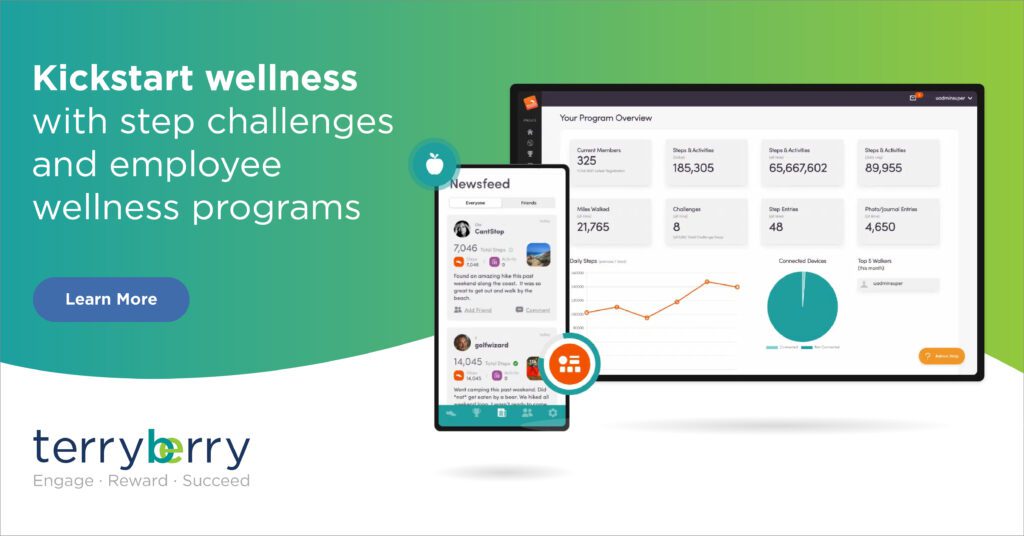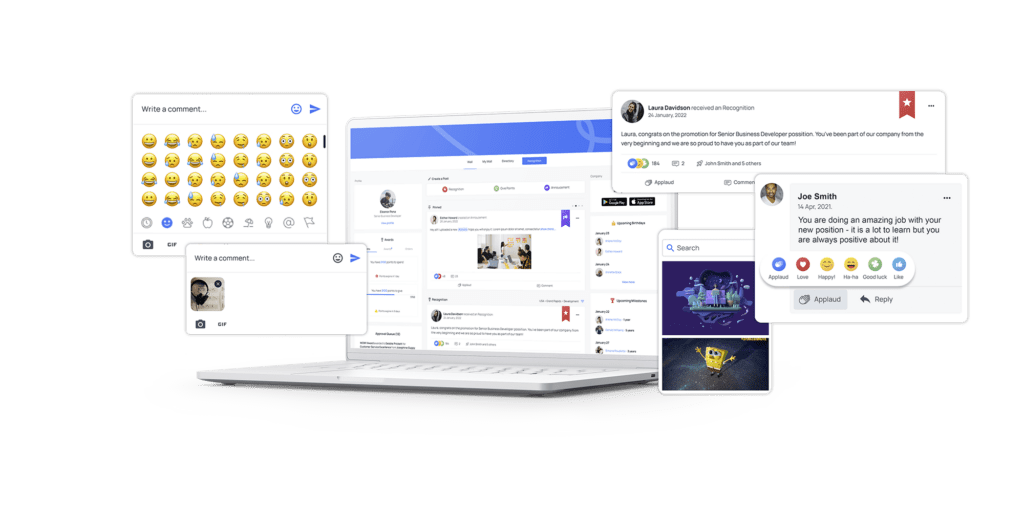October 16, 2023


If you've been hearing more and more about workplace wellbeing lately, you're not alone. The COVID-19 pandemic undoubtedly accelerated the evolution of work and the conversation around workplace mental health and well-being.
Today, more than half of all companies and over 90% of large companies in the United States offer a wellness program. This figure points to a deeper value shift occurring throughout organizations - there's a growing recognition of the connection that leaders see between employee well-being and organizational success.
Here, we'll explore what well-being in the workplace looks like, why it's important, and how to ensure your company is supporting employee wellbeing.
What is Employee Wellbeing?
Employee wellbeing refers to the physical, mental, and emotional health, satisfaction, and overall quality of life of an organization's employees. It encompasses a wide range of factors that contribute to an an organization or individual's overall sense of happiness and contentment within their work environment.
Employee well-being is a critical aspect of human resources management and is often associated with several key components:
Physical Health: This includes factors such as access to healthcare, ergonomic workspaces, nutrition, and exercise programs. Employers may offer wellness initiatives and healthcare benefits to support employees in maintaining their physical well-being.
Mental Health: Employee well-being includes mental health support, such as programs to help manage stress, finding ways to work with employees with mental illness, and creating an environment that reduces stress and promotes psychological well-being. This is increasingly important as awareness of mental health issues in the workplace grows.
Work-Life Balance: Maintaining a balance between work and personal life is essential for employee well-being. Employers can support this by offering flexible work arrangements, paid time off (PTO), and reasonable working hours.
Job Satisfaction: Job satisfaction is a critical component of employee well-being. It relates to how content employees are with their roles, responsibilities, and their workplace environment. Factors that contribute to job satisfaction include job security, career development opportunities, recognition, and a positive company culture.
Emotional and Social Wellbeing: Building meaningful friendships with colleagues, fostering a supportive and inclusive workplace culture, and promoting psychological safety all contribute to employee social wellbeing.
Financial Well-being: Employee well-being also encompasses financial wellbeing, stability, and security. This can involve fair compensation, retirement savings plans, and financial education programs.
Personal Development: Supporting employee growth and development by offering training and educational opportunities contributes to well-being. This can help employee engagement and motivation.
Physical Environment: The workplace physical environment, including factors like lighting, noise levels, and workspace design, can impact an employee's well-being and productivity.
Today, more and more employers recognize that promoting employee well-being and workplace conditions is not only a moral imperative but also makes good business sense.
A healthy, satisfied, and engaged workforce tends to be more productive, innovative, and less likely to experience burnout, turnover, or absenteeism. Consequently, many organizations invest in programs designed to improve employee wellbeing.


The Benefits of Employee Well-Being
Simply put, when you don't feel your best, you can't perform your best - and your employees are no different. Prioritizing employee well-being can not only help your employees feel good, it can lead to some significant business outcomes too.
Some of these benefits include:
Reduced Healthcare Costs
A Harvard Wellness Program Meta Study found that for every dollar that’s spent on an employee well-being program, a company saves $3.27 because of reduced healthcare costs.
One reason for this is that when companies prioritize employee well-being, it helps employees become more aware of their physical and mental well-being. This can encourage employees to make healthier choices throughout their lives resulting in better health outcomes overall.
Increased Employee Retention
People want to work at companies that value them as whole people, rather than just workers. So much so, one study found that a healthy company culture is 10 times more important to employees than pay.
So, prioritizing employee health helps people feel that they're in the right place, making them less likely to leave, ultimately improving employee retention.
Reduced Absenteeism
Burnout, stress, and depression are among the top most common reasons cited for employee absenteeism. Employees who are phsyically and mentally supported are less likely to take sick days or extended leaves. Therefore, promoting employee well-being can lead to decreased absenteeism.


Helps Prevent Burnout
Employee well-being initiatives are designed to help prevent employee burnout, by fostering a culture of work/life balance, mental wellness, and healthy habits. So, when done correctly companies should see a decrease in overall employee burnout.
Lower Turnover
Companies that prioritize employee well-being tend to have lower turnover rates. Satisfied and well employees are less likely to leave their jobs, reducing the costs associated with recruitment and training.
Improved Employee Engagement
When all of this comes together, employees are more likely to be motivated, committed, and enthusiastic about their jobs.
In fact, a 2017 survey found that 85% of companies say well-being programs support employee engagement. Additionally, 42% of the survey respondents reported that their top reason for implementing a wellness program was to improve employee engagement.
How to Improve Employee Well-Being
Improving employee well-being requires a multifaceted approach that takes into account physical, mental, and social aspects of wellness. Here are some strategies and practices that organizations can implement to enhance the employee experience and well-being:
Work-Life Balance
A vital aspect of employee well-being involves recognizing the significance of maintaining a healthy equilibrium between work, leisure, and its pivotal role in preventing burnout. In fact, a study conducted by Indeed has unveiled that 36% of the workforce emphasizes the potential for additional time off as a means to mitigate burnout.
However, it's crucial to note that merely extending PTO doesn't automatically translate to improved work-life balance for employees. According to a survey by Glassdoor, while PTO was deemed more valuable by employees than pay raises, a significant number of individuals fail to take advantage of their allotted time off.
In a disconcerting revelation, the U.S. Travel Association's 2017 Project: Time Off survey disclosed that a staggering 206 million vacation days remained unused by workers in 2016.
This scenario should prompt leaders to question why their employees might be hesitant to utilize their earned time off. Are their demands and deadlines during work hours too stringent? Is there a deficiency of support during their absence? Does the company culture inadvertently discourage the use of vacation days?
Rather than merely addressing the issue with additional PTO, the focus should shift towards supporting a healthier balance between work and personal life. This can be achieved by:
- First, ensuring that your team understands the mechanics of their PTO, where to access the information, and how to request time off.
- Leading by example - demonstrate the importance of unplugging after working hours and utilizing your own PTO.
- Organizing non-work-related events for enjoyment, such as happy hours, team lunches, and off-campus activities.
- Maintaining regular check-ins with your team to ascertain that their workloads remain manageable.


Fostering a Positive Work Environment
Arguably, the linchpin for all managers achieving comprehensive employee well-being is the workplace culture.
A healthy corporate culture is intricately tied to heightened personal job satisfaction, reduced employee turnover, and increased engagement. Unfortunately, the majority of companies seem to fall short in cultivating a conducive culture.
Research conducted by Gallup reveals that a mere 2 out of 10 employees feel a meaningful connection to their organization's culture. Moreover, only 27% strongly endorse their company's values.
Therefore, it's unsurprising that in 2022, employee engagement dwindled to a mere 32%, down from 36% in 2020 and 34% in 2021, while employee disengagement is on the rise, with 18% of employees now expressing active disengagement.
To bolster employee well-being, prioritize the nurturing of your company's culture. Here are a few suggestions:
- Foster a culture of recognition: An astonishing 82% of individuals derive greater happiness when they receive recognition at work. Incorporating recognition programs into your corporate culture can help many employees feel appreciated, respected, and like they belong.
- Invest in Diversity, Equity, and Inclusion (DEI): DEI initiatives can create a psychological safety net for employees. Research also indicates that companies with robust DEI strategies exhibit more innovation, better employee retention, and improved business outcomes.
- Prioritize open communication: Gain a genuine understanding of employee sentiments and catch workplace problems early through pulse surveys, engagement surveys, and 360-degree feedback.
Create a Workplace Wellness Program
The data is in – employee wellness programs benefit everyone involved. The strong support system of a wellness program cultivates long-term healthy habits in employees, leading to improved quality of life, and even a longer life span.
Employers who use wellness programs to support employee health and well-being also see returns on their investment and improvements in the overall workplace culture.
Study after study has found that a strong employee wellness program:
- Increases productivity and employee engagement.
- Decreases physical health risks and increases healthy behaviors.
- Reduces company medical costs.
- Decreases employee turnover and absenteeism.
- Improves recruitment and retention.

Identifying Employee Passions and Strengths
A crucial facet of employee well-being hinges on experiencing a sense of purpose in one's work. Business leaders can facilitate this by aligning their team's career aspirations, passions, and strengths with their job responsibilities.
Consider conducting one-on-one sessions with your team to identify their strengths and passions, and how these align with their current roles. It's possible that an employee who is currently delivering mediocre work could shine in a different team or might simply need a realignment of priorities.
Online self-assessment tools geared toward identifying strengths can also be a valuable resource in this process.
Embracing Professional Growth and Development
Despite trends like "Quiet Quitting" and "Lazy Girl Jobs," research continues to support the idea that most employees desire opportunities for growth, development, and advancement. The ability to cultivate skills is a fundamental component of overall wellbeing.
Companies that embrace a culture of growth are more likely to attract and retain high-performing, talented employees who develop stronger bonds with the organization, particularly among younger employees.
A LinkedIn study reports that 40% of young workers are willing to accept a 5% pay cut for positions offering career growth opportunities, and 76% of Gen Zers seek more opportunities for career advancement.
Employee development options encompass:
- Participation in career development conferences.
- Access to online courses or higher education.
- Taking on more challenging responsibilities.
- Tailoring learning opportunities to suit each employee's learning style.
These activities can:
- Enhance an employee's performance in their current role.
- Spark curiosity or uncover hidden talents.
- Enhance personal satisfaction in the job.
- Offer insights into other roles within the industry.
- Positively impact employee mental health at work.

Discovering Meaning and Purpose in Your Career
Purpose and occupational well-being are intrinsically linked. When a company exudes purpose, its employees follow suit. A study from McKinsey demonstrates that 70% of employees derive their sense of personal satisfaction and purpose from their work. Meaningful work leads to improved performance, heightened commitment, and reduced turnover.
To connect what your employees do with their passions, consider these strategies:
- Identify personal interests and hobbies that could enhance the workplace. For instance, an accountant might have a passion for fitness and could initiate a walking club within the company.
- Reinforce the importance of each employee's role in achieving the company's mission. Offer specific examples, such as recognizing the customer service team for their patience and empathy in keeping clients happy. Or thank sales professionals for their ability to connect with customers, which drives revenue.
Everyone plays a vital role, and it's essential to remind them of their significance.

Make Terryberry a Part of Your Wellness Program
We make it easy to launch wellness challenges that keep employees engaged and motivated. Our comprehensive app allows employees to track fitness, mood, sleep, nutrition, mindfulness, and other metrics. Employees can also connect via the platform to encourage each other through message boards.
As an administrator, you’re provided with expert content and communication templates, detailed challenge results, and dedicated customer support. Contact us today to learn more!
Terryberry is the Only End-to-End Employee Engagement Company
In addition to corporate wellness programs, Terryberry provides solutions to help drive performance and retention through all facets of employee engagement: These solutions include:
- Employee Survey Software: Be Heard is an employee engagement survey solution that's designed to enhance your employee experience while fueling business performance.
- Service Awards and Performance Awards: Recognize and reward employees based on years of service awards, anniversaries, or performance.
- Peer Recognition: Empower your employees and managers to recognize their peers and celebrate successes with an easy-to-use social recognition application.
- Feedback and Communication: Unlock improved feedback and communications with employee and customer feedback solutions.
- Wellness Programs: We make it easy to run wellness programs and activity challenges that increase worker engagement, expand corporate health, and build team camaraderie.
Ready to learn more? Schedule a demo with our team to get a hands-on walkthrough of how Terryberry can transform the culture of your workplace.



